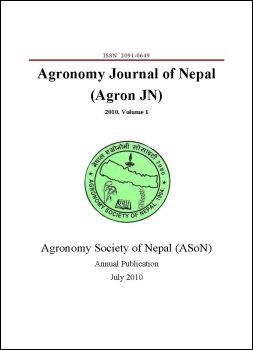Simulations of nitrogen dynamism in maize and rice by using CSM-CERES-maize and rice models under Chitwan, Nepal
DOI:
https://doi.org/10.3126/ajn.v1i0.7548Keywords:
CSM-CERES-Maize, CSM-CERES-Rice, Nitrogen dynamics, model evaluationAbstract
Crop modeling is being popular in the field of agriculture as a precision tool for resources allocations and their effective utilizations. Two separate field and simulation studies were accomplished in maize and rice that were laid out in the two factor factorial randomized complete block design at Agronomy Farm of Institute of Agriculture and Animal Sciences, Rampur, Chitwan Nepal during spring and rainy season of 2007 and 2008, respectively. CERESmaize and rice models were calibrated using the best performing treatments (7.41 x 104 plants /ha for all 3 varieties of maize i.e. Rampur Composite, Upahar and Arun 4 and 160 kg N /ha for Prithivi and Sunaulo Sugandha, and 120 kg N /ha for Masuli varieties of rice). Models were validated using the remaining treatments (6.36, 5.56 and 4.76 x 104 plants /ha for all varieties in maize and 40, 80 and 120 kg N /ha for Prithivi and Sunaulo Sugandha and 40, 80 and 160 kg N /ha for Mansuli in rice) to predict growth and productivity of different varieties of maize and rice. Model calibration was done with the determination of genetic coefficients and validation was accomplished with the comparison of observed and simulated values on anthesis days, maturity days, leaf area indices, above ground biomass at maturity, unit weight, and grain yields for both maize and rice. The simulation results on nitrogen dynamics revealed that the nitrification and leaching losses were higher under the conditions of non-flooded maize whereas ammonia volatilization and denitrification losses were higher in the conditions of alternately wetting and drying flooded rice field. The degree and magnitude of N-loss is higher when the N-level is advancing under both field conditions. However, volatilization was almost nil in the non-flooded maize. Results indicated that CERESmaize and rRice models could be applied in simulating the agronomic management options including the efficiency of N-application under the conditions of availability of complete datasets required to run the Cropping System Models (CSM)-CERES-maize and rice models embedded under Decision Support System for Agro Technology Transfer (DSSAT) ver 4.2 in the coming days.
DOI: http://dx.doi.org/10.3126/ajn.v1i0.7548
Agronomy Journal of Nepal (Agron JN) Vol. 1: 2010 pp.94-102
Downloads
Downloads
Published
How to Cite
Issue
Section
License
ASON permits for free use, distribution and reproduction in any medium if the original work is properly cited and not used for commercial purposes.




